
By Jill Lowe
The babbling book, the gentle fountain, that trickling of water to dampen the city sounds, yet to allow for birdsong, is what many seek in creating a certain ambiance in a garden, or courtyard.
Of course for those living, sleeping, or dining within the sound and sight of the thundering, crashing sound of the surf or the lapping of lake waves, this quest is not usually uppermost.
Inspiration and ideas to create the desired atmosphere can come from many sources, some from nature itself or else from grand or historical gardens, where one can observe clever and beautiful water features. Some such inspired water features are described here. Too, garden centers, as well as landscape designers, are filled with ideas to give that sensory rhythm.
A rill is defined as a shallow channel cut into the earth by the erosive action of flowing water. Larger incised channels are known as gullies, even larger are ravines. Artificial rills are constructed to carry a water supply from a distant source: an aesthetic water feature.
Looking first at natural rills and gullies, my mind immediately goes to Bundanoon in an area known as the Southern Highlands outside Sydney, NSW, Australia. Bundanoon is a word from the local aboriginal name meaning “place of deep gullies”. Pervading the bushland around Bundanoon are rills and gullies hewed into the rocky terrain.
One such rill is at the bottom of the Fairy Bower Falls Walk in a rocky picnic area bisected by rills. Over the many years, people have carved indentations into the rocky edges of the rill to allow for children to create “water wheels” (simple contraptions of twigs and leaves to allow the water to turn them, delighting all.)
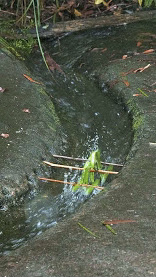
“the water wheel” into the grooves on rocky edge |

Jill at the bottom of Fairy Bower Falls walk in the 50’s |

Photo permission of Suzric Jan 2017- Trip advisor
Oh, and on the way down, the seemingly delicate Fairy Bower Falls.

The man-made rill shown above, at the National Botanical Gardens in Wales, runs down the hill serving as some control for escaping water.
 Photo : License with Shutterstock
Photo : License with Shutterstock
Man-made rills date back to Persia. Later in 13th and 14th centuries, rills appear in Europe. Above in Granada: the Alhambra Palace and Moorish gardens.

Photo courtesy:
Paul Rappoport Heritage 21
The canal at the grand, romantic garden of Kennerton Green, Mittagong, NSW, in the Southern Highlands, is said to be based on an irrigation canal that brought water to the vegetable garden adjacent to the Alhambra.
Later in England, emerged the onset of The Grand Tour of Italy, or as Monty Don: the British horticulturalist said, was really the eighteenth century “gap year”- it being the ultimate educational rite of passage for eighteenth-century British elites. With the likes of William Kent (1685-1748) spending time in Italy, his return to England saw a shift in English gardening from a more formal style to one of harmony between house, garden, and countryside.
At Rousham House and Gardens, 12 miles north of Oxford, William Kent completed the original design of the royal gardener Charles Bridgeman. The collection of follies, statues, ponds, hedges, an abundance of every color of green, streams, glades, vistas, and of course the rill, is truly an amazing delight.
The Rousham House and Gardens website https://rousham.org say in visiting Rousham “you can take any number of paths. One way takes you into the William Kent gardens with pools, a rill, cascades, statuary, and a seven arched colonnade called
Praeneste modeled on the ruins at Palestrina in Italy, which is set into a steep bank overlooking the river Cherwell and the Heyford bridge.”
Jane Owen: the editor of House & Home: Financial Times writes on MARCH 21 2014 “William Kent’s English landscape revolution at Rousham“. “In the dappled shade of woodland, a formal rill materialises and leads down to The Cold Bath beside an Octagonal Pool.”

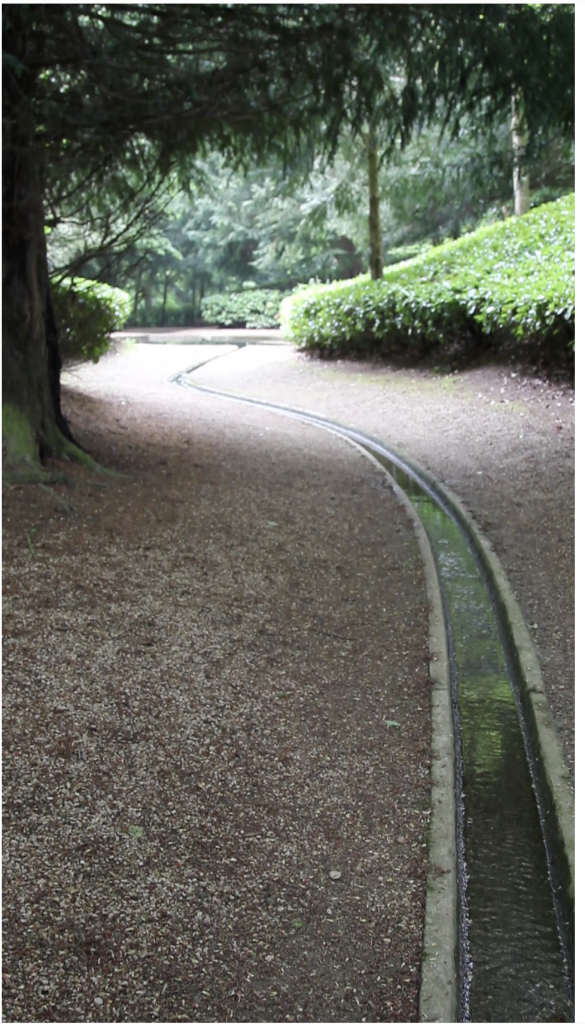


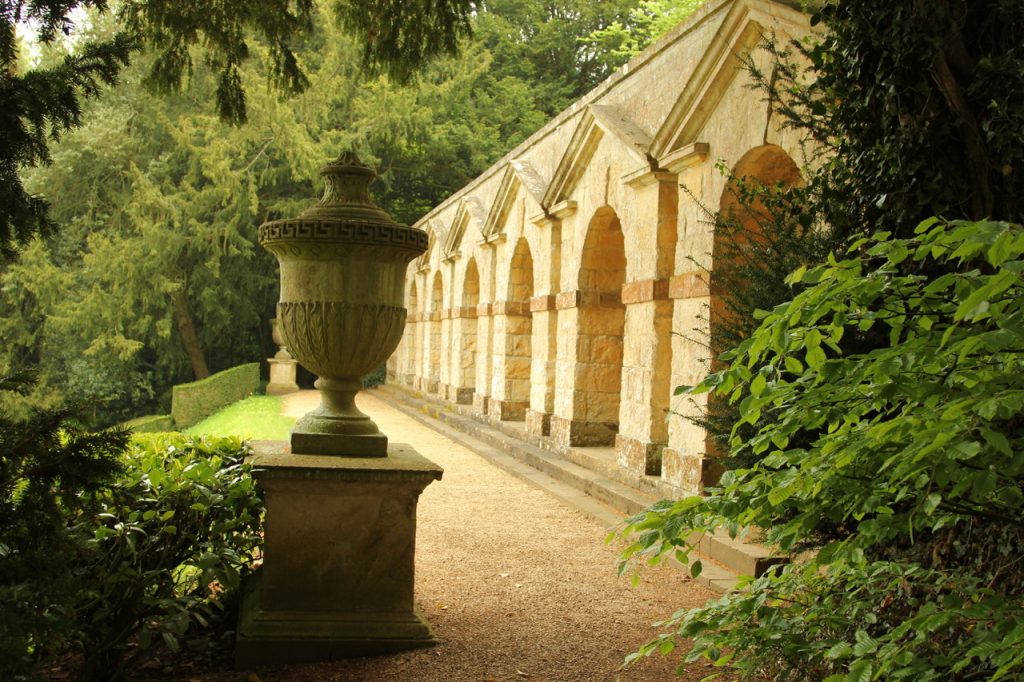
More of Rousham Gardens and the river Cherwell, Statue of Venus and Pan in the Vale of Venus, Praeneste – the 7 bay arcade
Shute House in Dorset, England, and its rill appears to be considered the gold standard for rills. First engineered and installed in the ’60s, the late Sir Geoffrey Jellicoe was again consulted in 1996 to revitalize the garden. Considered by many as his finest work, the rill uses water from the River Nadder to run over copper ledges: all elements placed so as to produce particular sounds, akin to music. for beautiful photos and more information on Shute House gardens especially the rill, look for link in notes.
The rill at Shute house was the basis for the brief given by my friends to Myles Baldwin: their landscape designer when they installed their rill in Sydney. Following the curve of the driveway, the 65-foot rill is fed by circulated, filtered rainwater from the top pond. The rainwater is collected from the house roof to a 23,000-gallon storage tank under the lawn.

Photo Courtesy Sally Ellick
Recycled bricks were cut to shape and Myles then played with varying arrangements to create different sounds and textures of water flow. A pipe set two inches above the water level in the small, upper pool sends a low fountain into the air and sets the water spilling down the rill.
The three drop-off points along the rill provided opportunities to stage a different brick pattern and then the bricks of the channel itself are set with pointed edge uppermost, to ripple the moving water.
 |
 |
Photos courtesy Sally Ellick
They love the music of both the moving water and the sounds of the many frogs who make the lower pond their home.
The Shute House rill is even thought to have influenced Frank Cabot at Quatre Vents in La Malbaie, Quebec, Canada at that absolutely magical garden which has a somewhat similar rill. Frank Cabot, born in Manhattan in 1925, founded the impactful Garden Conservancy in 1989. See reference in Notes to Mr. Cabot’s book published in 2001.
The sumptuous book by its Chairman Emeritus, Benjamin Lenhardt “Gardens of the North Shore of Chicago”, allows us to delve into some amazing gardens.

It is because of the Garden Conservancy that we can visit gardens not normally open to the public. We can thank the Garden Conservancy for their Open Days to have been able to visit Mettawa Manor here in the Chicago area. Bill Curtis and Donna La Pietra are the second owners of the 65-acre property which has 2 ponds and plenty of fountains to provide those sounds.
An aqua theater, with small fountains rippling the water, has a stage in the middle of the pond allowing for different music of perhaps a violin quartet. Completely enchanting.
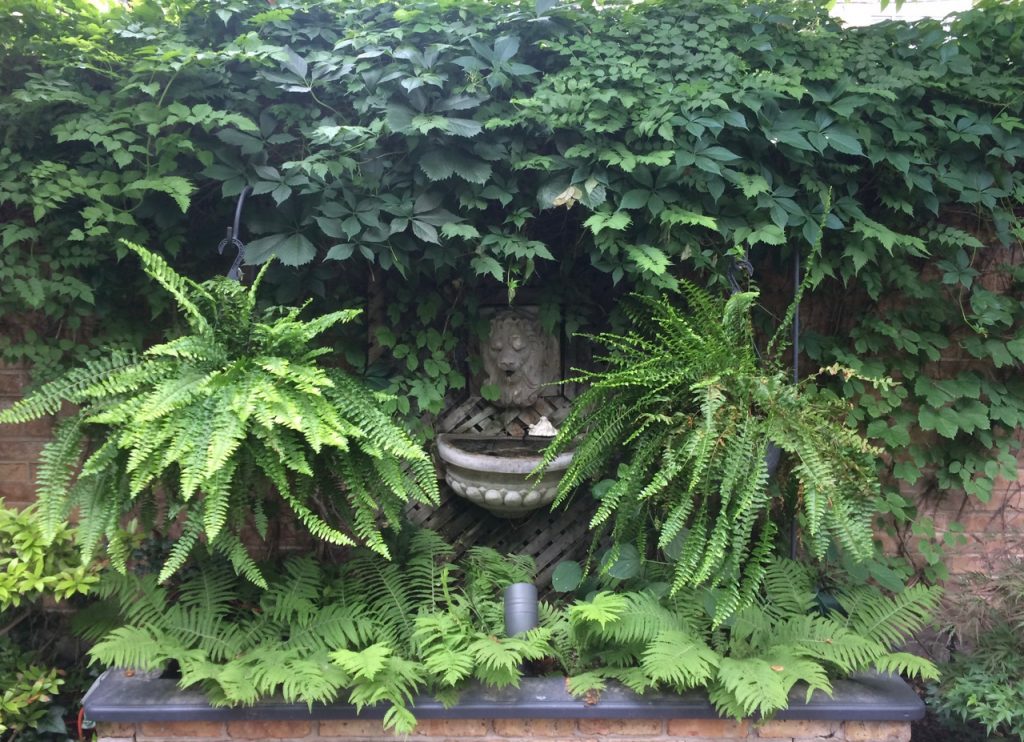
Local garden walks in Chicago have allowed us into gardens and those small city gardens have some wonderful water features providing that peaceful, bubbling sound of water and even some koi.
 |
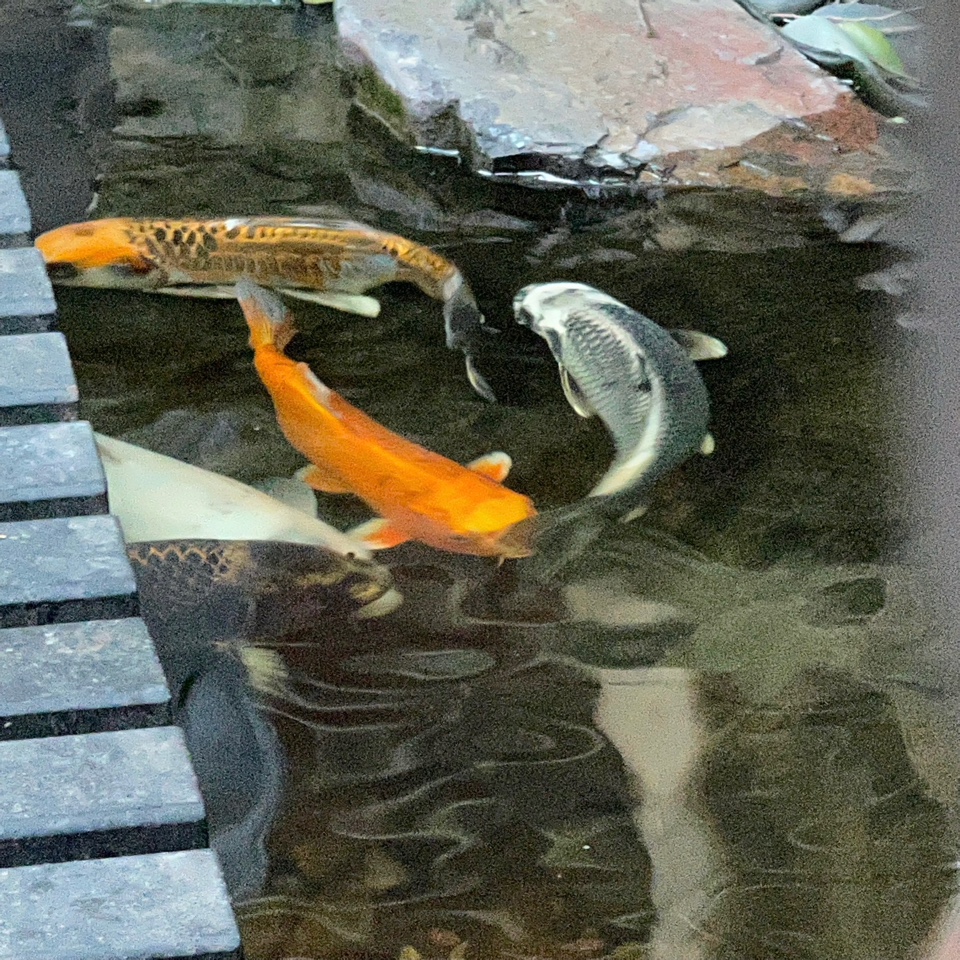 |
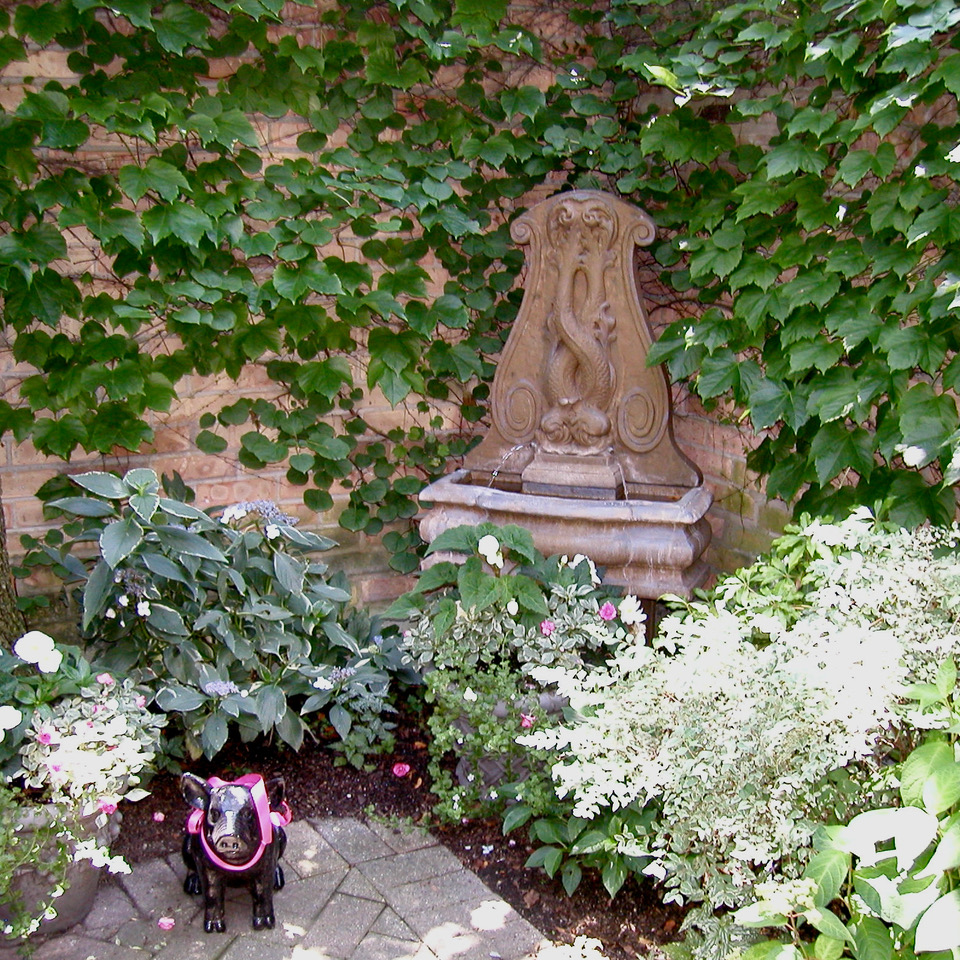 |
 |
 |
 |

The Madlener House on West Burton Place, Chicago: the architectural fragment courtyard & fountain.
 |
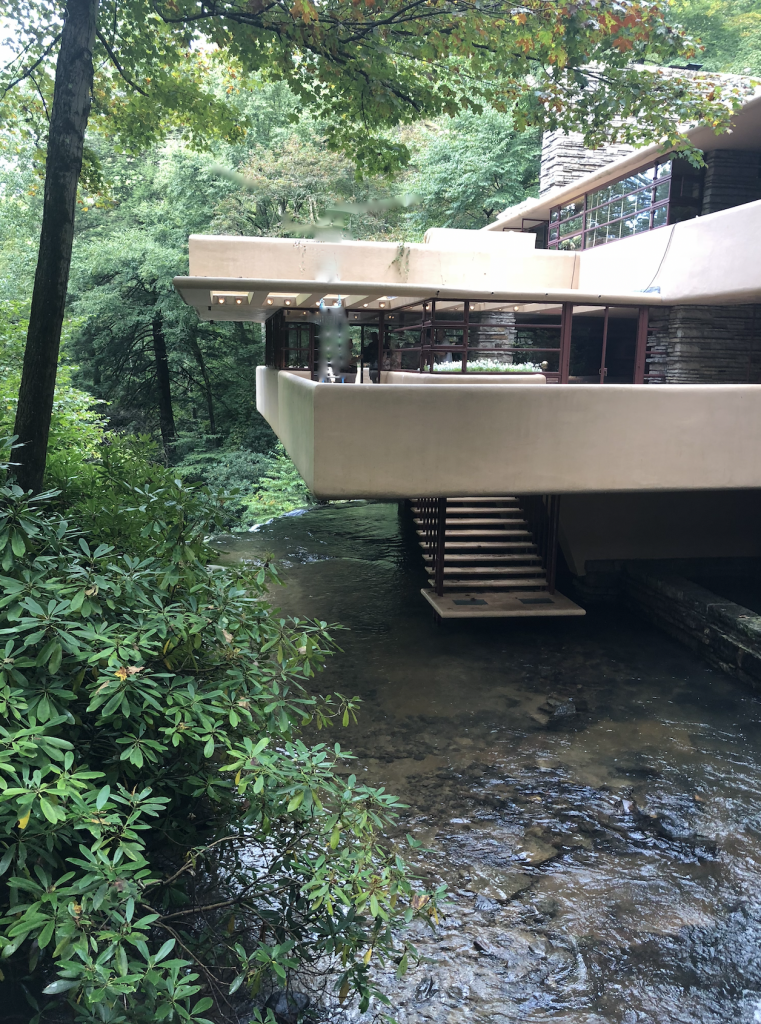 |
Probably the ultimate achievement in bringing water sounds to a house is Frank Lloyds Wrights’ 1939 Fallingwater, in Southwest Pennsylvania. described extensively in this magazine Jan 1, 2022, by Elizabeth Richter.
As one descends the stairs from the house to bathe in the stream in the Bear Run Nature reserve, the sound of the water is gentle bubbling: at this point, the roar of the falls beyond is minimized.
Not many of us will build a house over a stream and falls, but the many aquascape designers underscore how we are stirred to bring that babbling brook sound to everyday living for our own delight.
Notes and further reading.
Photo of Jill : Joe Mazza Bravelux inc.
Photos not attributed- copyright © 2022 Jill Lowe. All rights reserved
The Gardens of Chicago’s Gold Coast 1999 Carol Truesdell and NDA Association
Book: The Gardens of the North Shore of Chicago Benjamin Lenhardt 2020
https://www.houseandgarden.co.uk/gallery/gardens-shute-house
www.heritage21.com.au Paul Rappaport photo
Book: The Greater Perfection: The Story of the Gardens at Les Quatre Vents, published in 2001.






